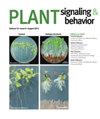GIGANTEA regulates PAD4 transcription to promote pathogen defense against Hyaloperonospora arabidopsidis in Arabidopsis thaliana
IF 2.8
4区 生物学
Q3 BIOCHEMISTRY & MOLECULAR BIOLOGY
引用次数: 3
Abstract
ABSTRACT Plants have evolved a network of complex signaling pathways that allow them to cope with the fluctuations of internal and external environmental cues. GIGANTEA (GI), a well-known, highly conserved plant nuclear protein, has been shown to regulate multiple biological functions in plants such as circadian rhythm, light signaling, cold tolerance, hormone signaling, and photoperiodic flowering. Recently, the role of GI in disease tolerance against different pathogens has come to light; however, a detailed mechanism to understand the role of GI in pathogen defense remains largely unexplained. Here, we report that GIGANTEA is upregulated upon infection with a virulent oomycete pathogen, Hyaloperonospora arabidopsidis (Hpa), in Arabidopsis thaliana accession Col-0. To investigate the role of GI in Arabidopsis defense, we examined the pathogen infection phenotype of gi mutant plants and found that gi-100 mutant was highly susceptible to Hpa Noco2 infection. Notably, the quantitative real-time PCR showed that PHYTOALEXIN DEFICIENT4 (PAD4) and several PAD4-regulated downstream genes were downregulated upon Noco2 infection in gi-100 mutant as compared to Col-0 plants. Furthermore, the chromatin immunoprecipitation results show that GI can directly bind to the intronic region of the PAD4 gene, which might explain the mechanism of GI function in regulating disease resistance in plants. Taken together, our results suggest that GI expression is induced upon Hpa pathogen infection and GI can regulate the expression of PAD4 to promote resistance against the oomycete pathogen Hyaloperonospora arabidopsidis in Arabidopsis thaliana.GIGANTEA调节PAD4转录促进拟南芥对拟南芥透明膜孢子虫的病原体防御
植物已经进化出一个复杂的信号通路网络,使它们能够应对内部和外部环境信号的波动。GIGANTEA (GI)是一种众所周知的高度保守的植物核蛋白,在植物的生理节律、光信号、耐寒性、激素信号和光周期开花等多种生物学功能中起着调节作用。最近,胃肠道在对不同病原体的疾病耐受性中的作用已经被发现;然而,了解胃肠道在病原体防御中的作用的详细机制在很大程度上仍未得到解释。在这里,我们报道了在拟南芥加入Col-0时,GIGANTEA在毒力强的卵菌病原体——拟南芥透明operonospora Arabidopsis (Hpa)感染后上调。为了研究GI在拟南芥防御中的作用,我们检测了GI突变体植物的病原体感染表型,发现GI -100突变体对Hpa Noco2感染非常敏感。值得注意的是,实时荧光定量PCR显示,与Col-0植株相比,gi-100突变体在Noco2侵染后,PHYTOALEXIN deficit 4 (PAD4)和PAD4调控的几个下游基因下调。此外,染色质免疫沉淀结果表明,GI可以直接结合PAD4基因的内含子区,这可能解释了GI在植物抗病调控中的作用机制。综上所述,我们的研究结果表明,Hpa病原菌感染诱导了GI的表达,GI可以调节PAD4的表达,从而促进拟南芥对卵菌病原菌拟南芥的抗性。
本文章由计算机程序翻译,如有差异,请以英文原文为准。
求助全文
约1分钟内获得全文
求助全文
来源期刊

Plant Signaling & Behavior
Agricultural and Biological Sciences-Plant Science
CiteScore
6.00
自引率
3.40%
发文量
111
期刊介绍:
Plant Signaling & Behavior, a multidisciplinary peer-reviewed journal published monthly online, publishes original research articles and reviews covering the latest aspects of signal perception and transduction, integrative plant physiology, and information acquisition and processing.
 求助内容:
求助内容: 应助结果提醒方式:
应助结果提醒方式:


